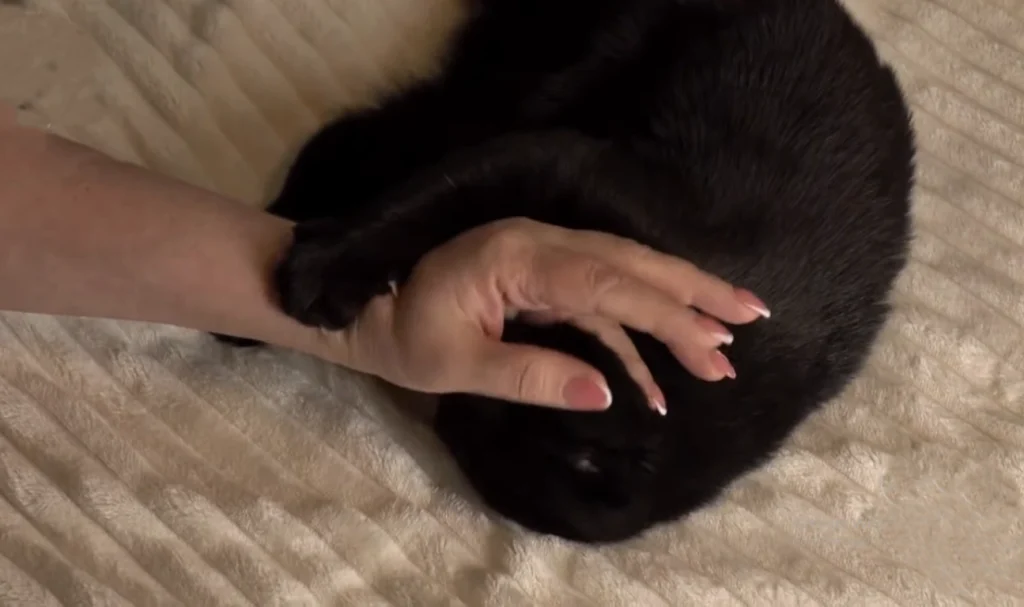Why Do Cats Scratch When You Pet Them? Understanding Feline Behavior and Communication
By: Elizabeth Rikas

The information in this article is intended to educate cat parents and is not a substitute for veterinary guidance. In case of any concerns about your cat’s health, please talk with your veterinarian.
Many cat owners have experienced the surprise of their furry friend suddenly scratching or biting during a petting session. This behavior often leaves them puzzled, wondering what went wrong. Cats may scratch when petted because they can become overstimulated or feel conflicted about the attention they are receiving.
Understanding the reasons behind this scratching can help owners create a more comfortable environment for their pets. Cats communicate their feelings and limits through their body language, and recognizing these signals can lead to a better relationship. With a little awareness, petting time can be enjoyable for both the cat and the owner.
By learning more about a cat’s scratching behavior and the factors that contribute to it, owners can make their interactions more positive and relaxing. This knowledge not only helps in managing behavior but also fosters a deeper bond with their feline companions.
Key Takeaways:
- Cats often scratch due to overstimulation during petting.
- Recognizing a cat’s body language can improve interactions.
- Understanding scratching behavior helps strengthen the owner-pet bond.
Related Read: Best age to declaw a cat
Understanding Cat Scratching Behavior
Cats scratch for various reasons related to their instincts and natural behaviors. This behavior serves important functions, including communication and territory marking, which are essential for their emotional and physical well-being.
The Role of Scent Glands in Scratching
Cats have scent glands located in their paws. When they scratch, they activate these glands, releasing a unique scent that conveys important information to other cats. This scent marks their territory, letting other cats know they have been there.
The act of scratching not only leaves physical marks but also imparts a chemical signature. This is how cats communicate ownership of a space. As they scratch, they stretch their muscles and keep their claws sharp, contributing to their overall health. Providing a suitable scratching surface can satisfy this instinct and help keep furniture safe.
Scratching as a Means of Marking Territory
Scratching serves as a vital tool for a cat to assert its presence in an area. By scratching furniture, posts, or other surfaces, they send a clear message to other animals. This behavioral instinct is about establishing boundaries and reinforcing status.
Furthermore, scratching can have a social aspect. When cats scratch, they may be communicating with other cats in the vicinity. This behavior can even vary based on the cat’s mood or environment. Providing designated scratching posts can help minimize unwanted scratching on household items and promote healthy behaviors.
Click to explore: How To Make Cats’ Fur Softer
Physical Aspects of Scratching
Scratching is a natural behavior for cats. It serves several important purposes, including maintaining their claws and marking territory. Understanding the physical aspects related to scratching can help cat owners create better environments for their pets.
Scratching Post Benefits
Scratching posts are essential for a cat’s physical and emotional well-being. They allow cats to sharpen their claws, which helps remove the outer sheath of their claws. This process keeps claws healthy and functional.
In addition to claw maintenance, scratching posts provide a designated area for cats to stretch and exercise. Cats instinctively scratch to stretch their muscles. A suitable scratching post can help prevent damage to furniture while catering to their needs.
Choosing the right type of scratching post is important. Options include vertical and horizontal posts made from various materials. Sisal and cardboard are popular choices that many cats enjoy. Regular use of scratching posts can help cats express their natural behavior in a safe manner.
The Effect of Catnip on Scratching
Catnip can greatly influence a cat’s scratching behavior. When cats come into contact with catnip, they often become playful and energetic. This excitement may lead to increased scratching.
Catnip contains a compound called nepetalactone, which many cats find irresistible. About 50-75% of cats show sensitivity to it. This reaction can lead to playful antics, which may encourage more scratching on designated surfaces.
Using catnip on scratching posts can entice cats to use them more frequently. Owners can sprinkle dried catnip on a scratching post or use catnip-infused products. This method helps direct their scratching behavior away from furniture and towards appropriate areas.
Click to learn about: Split Claws In Cats
Interactions Between Cats and Humans
Understanding how cats interact with humans enhances the bond between the two. Feline friends express their feelings in various ways, including scratching. Knowing the reasons behind this behavior and using appropriate techniques can create a more enjoyable experience for both parties.
Why Cats Scratch When Petted
Cats may scratch when petted for several reasons. One common cause is petting-induced aggression. This occurs when a cat feels overstimulated or annoyed while being touched. Signs of irritation can include a twitching tail or flattened ears.
Another reason could be sensitivity. Some cats have areas where they prefer not to be touched, and scratching can arise from discomfort. Understanding the cat’s body language is vital. If she suddenly scratches or bites, she may be signaling that the petting is too much.
Appropriate Petting Techniques
Using proper techniques when petting a cat can help avoid scratches. Start by petting the chin and cheeks, as these areas are typically well-received. Cats often enjoy gentle stroking in these regions.
It is important to avoid areas like the belly or tail unless the cat clearly shows she is comfortable. Pay attention to the cat’s reactions. If she moves away or shows signs of displeasure, stop petting.
Additionally, using a soft hand and making slow movements can help keep the interaction calm. Cats appreciate predictability in touch, so keeping the strokes gentle and consistent is beneficial.
Health Considerations in Scratching
Scratching is a natural behavior in cats, but it can also signal underlying health issues. Identifying the causes of scratching behavior is important for their well-being. Conditions such as allergies or other health problems may require veterinary attention.
Click to learn: Why is my cat breathing rapidly?
Identifying Allergies and Other Conditions
Cats may scratch due to allergies, which can stem from various sources like food, pollen, or fleas. Allergic reactions can lead to itchy skin, causing cats to scratch excessively. Signs of allergies include redness, swelling, or hair loss in affected areas.
Other health conditions, such as skin infections or parasites, can also cause itching and scratching. Identifying these symptoms early can help in providing the proper treatment. Regular veterinary check-ups are recommended to detect any underlying conditions.
When to Seek Veterinary Advice
If scratching becomes excessive or is accompanied by other signs such as vomiting, lethargy, or changes in appetite, it is essential to consult a veterinarian. They can conduct tests to determine the cause and recommend appropriate treatments.
Pet owners should pay close attention to changes in their cat’s behavior. If the scratching leads to injuries or infections, immediate veterinary care is necessary to prevent complications. Taking these steps ensures your cat remains healthy and comfortable.
Click to know: Whisker Fatigue In Cats
Frequently Asked Questions
Cats can scratch when being petted for several reasons. Understanding these causes can help cat owners manage their pet’s behavior during interactions. The following questions address common concerns and provide insights into this behavior.
Conclusion
Understanding why cats scratch when petted is key to fostering a harmonious relationship with your feline companion. Cats often scratch due to overstimulation, discomfort, or miscommunication, and recognizing their body language can help prevent these incidents. By paying attention to their cues and respecting their boundaries, pet owners can create a more enjoyable and stress-free environment for their pets.
Providing appropriate scratching surfaces and using gentle petting techniques can further enhance the bond between cats and their owners. With patience and awareness, petting sessions can become a positive experience for both parties, strengthening the connection and ensuring your cat feels safe and understood.

About the Author
Elizabeth Rikas
Elizabeth is a passionate advocate for feline health and well-being, drawing from her years as a dedicated pet parent to three cats—Gypsy, Swan, and Alfred—and her invaluable experience volunteering at animal shelters. A seasoned writer with a lifelong love for cats, Elizabeth began sharing her insights in her teens and has since contributed extensively to platforms focused on feline care. Through her expertise and heartfelt dedication, she empowers pet owners with practical advice and research-backed knowledge to nurture their furry companions.
